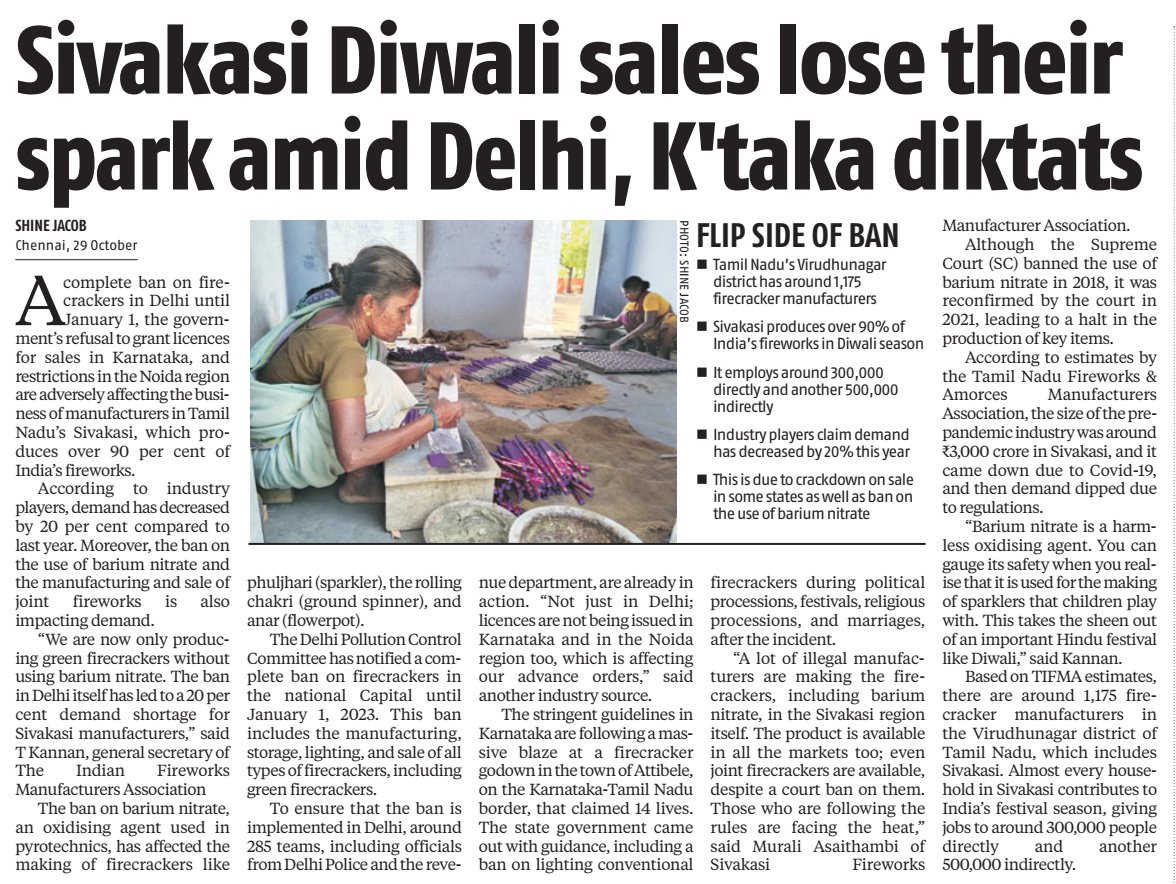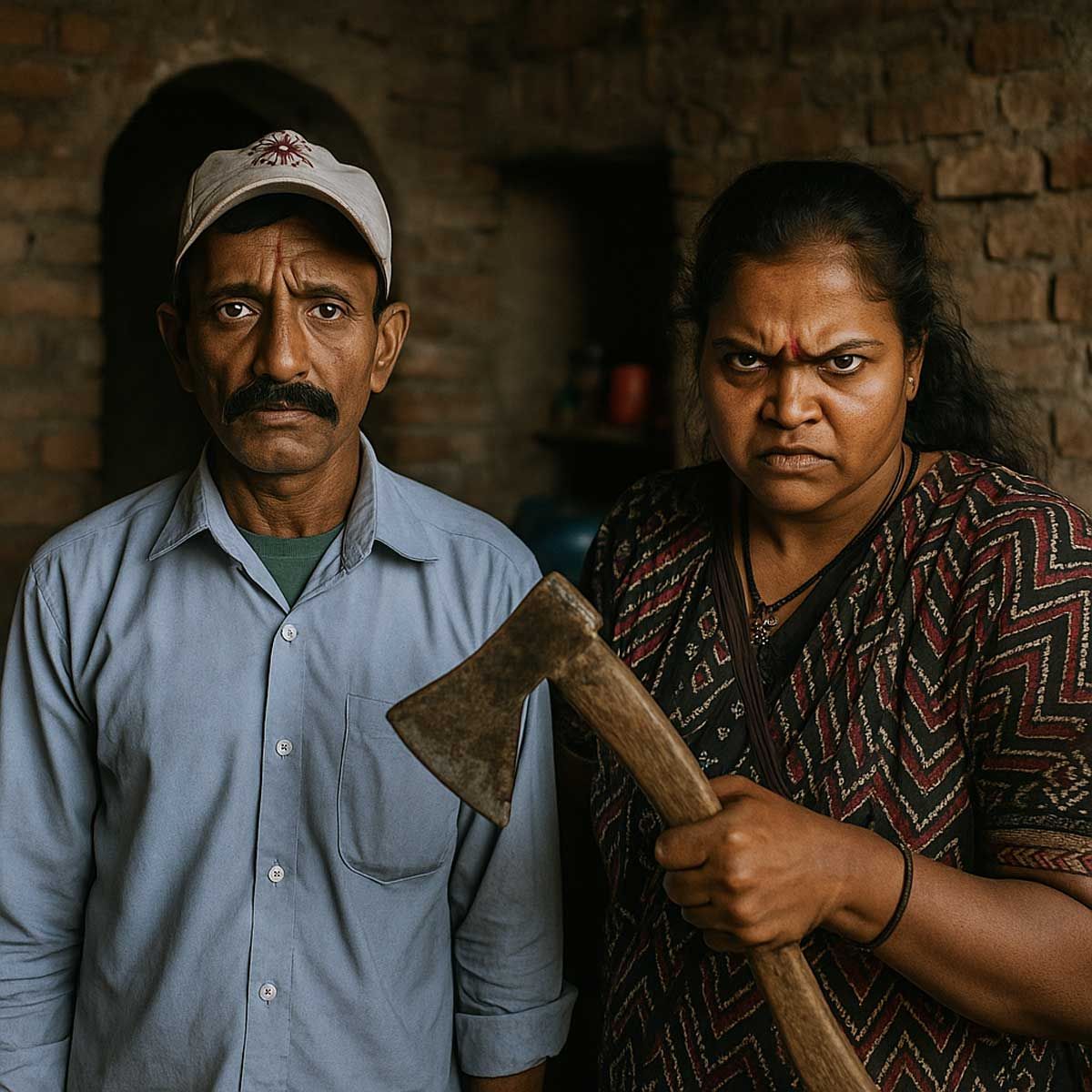More Coverage
Twitter Coverage
Satyaagrah
Written on
Satyaagrah
Written on
Satyaagrah
Written on
Satyaagrah
Written on
Satyaagrah
Written on
JOIN SATYAAGRAH SOCIAL MEDIA
"Uncertain Times in Fireworks Town": In Tamil Nadu's Sivakasi, the heart of India's firecracker industry, a staggering 8 lakh workers face an uncertain future as Delhi & other government bans dim the spark of their livelihoods, clouding the festive spirit

In the small town of Sivakasi in Tamil Nadu, often hailed as the "fireworks capital" of India, a crisis looms large. The town, with a rich legacy of 90 years in the firecracker industry, which accounts for 90% of India’s production, is facing an unprecedented challenge. This year, around 8 lakh industry workers find themselves on the brink of unemployment as a consequence of a series of bans on firecrackers by various state governments, including Delhi's blanket ban effective until January 1.
|
Sivakasi's economic backbone is its 8,000 firecracker factories, which not only fuel the local economy but also sustain the livelihoods of hundreds of thousands of workers and their families. The recent governmental restrictions, echoing in the streets of Sivakasi, resonate with the sound of silence rather than the usual festive crackles. With Karnataka denying sales licenses and Noida imposing restrictions, the ripple effect has been detrimental, resulting in a significant 20 percent shortfall in demand for Sivakasi's firecrackers.
This stringent stance taken by the Delhi government and others has sent shockwaves through the industry. The implications of these bans are more than just economic statistics; they represent the disrupted lives of workers, the uncertainties for their families, and a potential cultural shift away from one of India's traditional industries. As the debate on environmental concerns and health issues continues to intensify, the future of Sivakasi and its firecracker legacy hangs in the balance, underscoring the need for a dialogue that bridges the gap between sustainable practices and the preservation of livelihoods.
In the face of strict regulatory actions, Sivakasi's firecracker manufacturers have pivoted towards more environmentally friendly alternatives. T Kannan, the general secretary of The Indian Fireworks Manufacturers Association (TIFMA), points out, "We are now only producing green firecrackers without using barium nitrate." Despite this adaptive measure, the industry is reeling from a substantial decline in demand, particularly highlighting that "The ban in Delhi itself has led to a 20 per cent demand shortage for Sivakasi manufacturers."
 |
This decline not only quantifies the immediate economic impact but also symbolizes the plight of an entire community striving to align their livelihoods with the evolving environmental regulations. It reflects a scenario where traditional practices and modern environmental consciousness are at a crossroads, with significant livelihoods caught in the balance.
Further intensifying the situation is the Supreme Court's stance, which, on September 13, refrained from intervening in the Delhi government's decision to reinstate a comprehensive ban on firecrackers in the capital. This ban affects not just the production but also the sale, storage, and usage of all types of firecrackers in Delhi during the Diwali season—a period traditionally associated with their use.
The apex court's bench, which included Justices AS Bopanna and MM Sundresh, suggested that alternative forms of celebration should be considered. This statement came in the wake of BJP Lok Sabha MP Manoj Tiwari's remarks to the court, highlighting the contradiction in re-imposing the ban despite the allowance for green firecrackers, which are purportedly designed to be less harmful to the environment.
|
This judicial reluctance to engage with the ban, and the suggestion to find new ways to celebrate one of Hinduism's most significant festivals, has sparked a broader conversation on cultural adaptation in the face of environmental challenges. The court's decision not to interfere with the ban, while underscoring the importance of public health and environmental protection, raises questions about the future of industries traditionally linked with cultural practices.
The Supreme Court's recent decision not to intervene in the firecracker ban imposed by various states has intensified the debate on the intersection of tradition, public health, and environmental policy. The counsel representing BJP Lok Sabha MP Manoj Tiwari highlighted the nationwide impact, arguing, "There are many states imposing complete ban despite the orders of this court." The court's response was unequivocal: "Locally if there is a ban, there is a ban. We will not interfere. You can find other ways to celebrate."
This discourse takes place against the backdrop of the Delhi government's announcement on September 11, which reinstated a total prohibition on the manufacture, storage, sale, and usage of firecrackers in the capital. The rationale behind this stringent policy is to mitigate the severe pollution levels that envelop Delhi during the winter months. This decision echoes the measures taken over the previous two years when the Delhi government had implemented similar bans.
The recurring issue of firecracker bans surfaces annually as Diwali approaches, with fingers often pointed at the Hindu festival for contributing to the dire pollution crisis in Delhi and its adjoining regions. This contention has been met with critical scrutiny, as many argue that the festival's contribution to the pollution is minor and transient. They point to studies indicating that the primary pollutants stem from other sources, such as stubble burning in neighboring states, vehicular emissions, construction work, prevailing weather patterns, and the geographical positioning of the region.
Critics of the ban suggest that the focus on Diwali and its firecrackers is misplaced and disproportionately targets Hindu cultural practices. They argue that while environmental protection is undoubtedly crucial, the measures taken should be balanced and backed by scientific evidence that addresses all significant causes of pollution rather than singling out a religious festival. This perspective maintains that addressing the problem requires a comprehensive approach, tackling all sources of pollution to make a lasting difference.
Hit Hard by Cracker Bans, Sivakasi's Fireworks Losing Its Light
In the bustling lanes of Sivakasi, Tamil Nadu, the echoes of a distant legal verdict have dimmed the vibrancy of an entire town. As judicial and policy decisions on air pollution are made in urban centers like Delhi, the reverberations are felt in the streets of Sivakasi, where the livelihoods of about 6.5 lakh individuals hinge on the firework industry's fortune. The gavel's strike in courtrooms far away has a direct and profound impact on the daily lives of these workers.
The pattern is annual; as Deepavali approaches, last-minute rulings and regulations designed to combat air pollution suddenly upend the market, leaving Sivakasi's workforce to face the economic brunt. These workers, whose vulnerability to financial instability mirrors the susceptibility of city-dwellers to smoke-laden air, consistently find themselves on the losing end of this battle. The dual affliction of policy restrictions and the COVID-19 pandemic has slashed their income and decimated job opportunities.
P Vetrivel, a 30-year-old contract worker, shares his plight, "When times were better, I used to make 7,000-8,000 pieces a day." But now, the winds have shifted, and with a drop in demand, his production has fallen to 5,000 pieces daily. This reduction in output means his earnings have plummeted to nearly Rs 400 from the Rs 500-600 he once earned. "The loss of income," he laments, "has translated to choosing government hospitals over private facilities, buying fewer new clothes for children, and lower alcohol consumption."
Vetrivel's story is but a single thread in the larger tapestry of Sivakasi's woes. The town, once illuminated by the glow of its firework factories, now grapples with the darkness of economic insecurity. As the industry is forced to scale back, the workers' ability to provide for their families and partake in the very celebrations their labor once brightened is increasingly curtailed.
This situation paints a stark portrait of the human cost of environmental policies. While the intention behind the firecracker bans is to protect public health, the execution and timing have led to unintended consequences that reach far beyond the intended scope. The question that emerges from the smoky aftermath is how to balance environmental imperatives with the economic realities of those who are most impacted by these decisions.
The firecracker industry of Sivakasi, already navigating through the smog of stringent regulations, has been dealt another series of severe economic blows. From the demonetization wave to the implementation of the Goods and Services Tax (GST), the introduction of 'green crackers,' and the bans by various state governments, the industry's vibrancy is being snuffed out, leaving its workers in a tightening financial bind.
The ramifications of these policies are particularly harsh for the female workforce of Sivakasi, who are predominantly employed in non-chemical tasks such as labeling, assembly, and packaging. Despite their significant role in the production chain, these women workers receive only about half the wages of their male counterparts. P Annalakshmi, a worker crafting ground chakras, articulates the gravity of their plight. Her daily earnings have plummeted by nearly a third, now eking out a mere Rs 200 per day. She reveals, "I earn around Rs 1,000 a week, half of which is paid as interest to money lenders, whom I borrowed from during the lockdown." The remnants of her income are barely enough to sustain her household.
Meanwhile, male employees like 36-year-old Lenin Kumar confront a different aspect of the crisis—stagnant wages amidst rising inflation, which has effectively eroded their purchasing power. Kumar shares his distress, "My wages have remained stagnant at Rs 400 a day for the past six years." The consequences force austerity upon their tables: "With prices rising, we have had to keep our meals frugal — buy fewer veggies, have non-vegetarian food only once a month or substitute it with eggs."
The struggle in Sivakasi is not just a tale of declining wages but a stark reflection of the widening economic disparity and the gender wage gap that disproportionately affects women. As families are compelled to make do with less, the festivity that once symbolized abundance and prosperity has given way to austerity. The once-thriving fireworks industry now echoes with the stories of workers like Annalakshmi and Kumar, who symbolize the grim reality of an industry—and a community—on the brink. The situation begs for a reassessment of policies that while aiming for the greater good, should also account for the sustenance of those who fuel one of India's most colorful and traditional industries.
 Support Us
Support Us
Satyagraha was born from the heart of our land, with an undying aim to unveil the true essence of Bharat. It seeks to illuminate the hidden tales of our valiant freedom fighters and the rich chronicles that haven't yet sung their complete melody in the mainstream.
While platforms like NDTV and 'The Wire' effortlessly garner funds under the banner of safeguarding democracy, we at Satyagraha walk a different path. Our strength and resonance come from you. In this journey to weave a stronger Bharat, every little contribution amplifies our voice. Let's come together, contribute as you can, and champion the true spirit of our nation.
 |  |  |
| ICICI Bank of Satyaagrah | Razorpay Bank of Satyaagrah | PayPal Bank of Satyaagrah - For International Payments |
If all above doesn't work, then try the LINK below:
Please share the article on other platforms
DISCLAIMER: The author is solely responsible for the views expressed in this article. The author carries the responsibility for citing and/or licensing of images utilized within the text. The website also frequently uses non-commercial images for representational purposes only in line with the article. We are not responsible for the authenticity of such images. If some images have a copyright issue, we request the person/entity to contact us at This email address is being protected from spambots. You need JavaScript enabled to view it. and we will take the necessary actions to resolve the issue.
Related Articles
- "Hindus were attacked but nobody came to rescue us, what's wrong with chanting 'Jai Shri Ram? Do we stay in Pakistan": Suresh Sarkar who created chariot for Jahangirpuri procession and was detained
- Children got School sermons to not burst crackers on Diwali, this is how a mother responded
- Hanuman Jayanti procession permitted by MP Police with 16 conditions, entire route mapped by drones: Condition includes submitting a list of songs to play and avoid objectionable slogans or posters, etc.
- Founder of 'The Wire' and 'The Print' had a melodramatic meltdown while objecting to meat ban during Navratri: How meat has been used as a political tool to hurt religious sentiments of Hindus during festivals
- For the first time in the history of Tirupati, 30 devotees on foot stopped from reaching temple for carrying musical instruments up Tirumala hill by TTD: Devotees perform Nama Sankeerthanam during the journey
- Blanket ban on firecrackers by Calcutta HC, just ahead of Diwali: ‘Activist’ Roshni Ali filed PIL seeking ban
- Ad featuring Aamir Khan hurts Hindu sentiments: BJP MP Anantkumar Hegde writes to CEAT Tyres to make ad showcasing nuisance of namaz on roads, loudspeakers in mosques
- NASA data decodes that pollution on Diwali caused by stubble burning, not firecrackers: Media campaign against Diwali baseless
- Christian missionary St. Mary's school apologises after their derogatory skit on Ramleela went viral: Haryana
- "An audacious blow to our festivals and culture": Teacher Sunil Kumar suspended for lambasting KK Pathak over his order to terminate holidays on significant Hindu festivals, sparking a wider debate on preserving the sacred tradition of Raksha Bandhan
- Sri Ram Shobha Yatra attacked with stone-pelting in Mulbagal town of Kolar district in Karnataka, Sri Ram idol pelted, Cars and motorcycles ransacked by the miscreants, motorcycle set ablaze: After Karauli, Hindus come under another attack
- Aurangzeb banned Diwali 350 years ago, Courts and governments are just following Mughal ruler
- SC sets aside Calcutta HC’s Blanket Ban on Fireworks, reiterates there can’t be complete ban on firecrackers
- 130 attackers arrested in Noakhali, Bangladesh for violence against Hindus: So far out of thousands unnamed Islamists booked
- Charges framed against Tahir Hussain by Delhi Court for Delhi Anti-Hindu riots 2020: 5 accomplices, active participant, used own house for throwing stone, patrol bombs etc., elaborate preparations to target Hindus




























